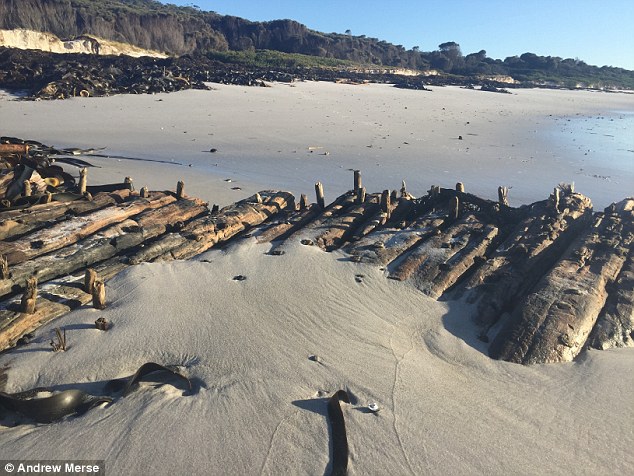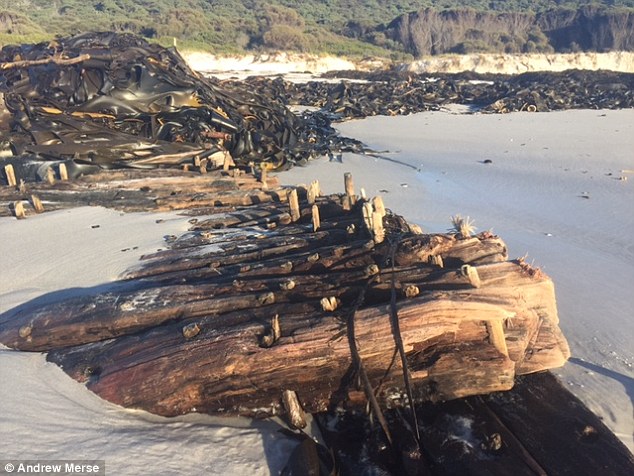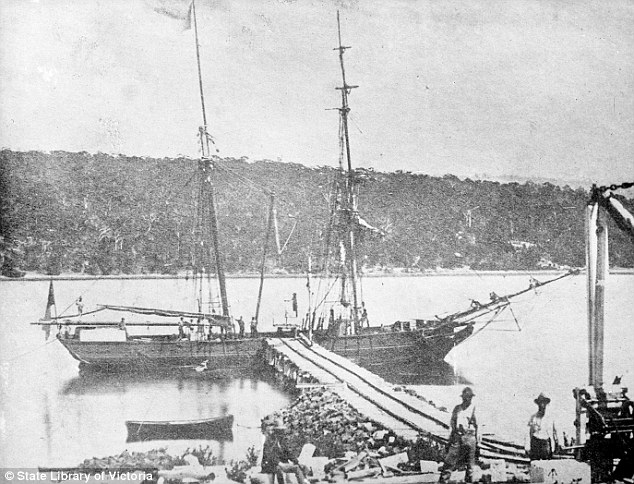In June, Tasmania was hit with severe weather and storms. The locals who live there were not expecting the storm to turn up something breathtaking, but the storms hit the beach shores hard, turning up a centuries old shipwreck.
The ship’s name is actually visible from the shore; locals read it as the Viola. The ship was wrecked right on the shore of the Friendly Beaches in the South East Coast. It originally wrecked and was washed ashore and broken into pieces in November 1857. Not surprising, the ship hasn’t been sighted for nearly 40 years, the last sighting being in 1976. The wreckage only shows up every so often if there is a great storm that allows the locals to view it, if only for a short amount of time.
Researchers and historians are still not quite familiar with Viola’s history. However, experts do say there were previous reports that the ship had been run aground after carrying coal from Newcastle, Australia to Tasmania.

One Parks and Wildlife Marine Historian, Mike Nash, told ABC that he had found a newspaper clipping that was written back in 1976, or so he believes. That is the only remaining newspaper article that reports the sighting of Viola.
The way to know for sure whether or not that ship is actually Viola would be to get some wood samples from the wreckage. Although it seems like an easy task, it is much easier said than done and recovery has been proven to be rather difficult.
Nash added that getting a sample is what many experts have difficulty with since ships like the Viola disappear rather quickly after being revealed for a short amount of time.
Some other information Nash knows is that the ship is believed to have been built in Canada. If they were able to take some samples, it could determine the ship’s actual origin and support whether it was built in Canada or not.

Nash explained that the storm had washed up an immense amount of weed and sand, resulting in the ship’s being covered with all of the storm’s debris and muck. He had said that he most likely won’t be able to get as detailed a record for newspapers and reporters as the 1976 article. Any bit of information about the ship during its sporadic uncovering is needed for experts and historians to learn about it.
Although he will not get a detailed article written, he will at least be able to record how it was revealed again in 2016. Nash also explained that with it being shipwrecked close to shore, sand comes in rather quickly to cover it right back up. This would mean that once there was a confirmed sighting, then a person would have to be there the first or second day to capture a full glimpse at the wreckage, or take photos if one decides to.
Another ship that took a turn for the worse near Tasmania’s South East had resulted in six people drowning. The ship was known as the Zephyr; it sank during the year of 1852. Only one woman passenger survived out of the rest of the crew.
Like the Viola, it takes a major storm to blow away the sand and muck from the Zephyr in order to be seen by locals. This only happens once in a great while, and the Zephyr is more sporadically seen than the Viola. The Zephyr sunk near Break Creek and was last sighted back in 2005. It only shows up every few years if a major storm allows it.

The Zephyr was a large Australian-built ship that weights 63 tons and was 62 feet high. This information was found in a Flinders University report. There were 14 passengers on board when it went down; there were eight lives lost and one female survivor.
It is thought that there are more than 1,000 shipwrecks in Tasmania. Only 70 to 80 of those have been found. Nash said that there are maybe about 20 that appear at certain times after storms. In fact, he said, there was one off the west coast in which only half of the ship was revealed about ten years ago from a storm. Nash gets detailed reports and is starting to sense a pattern; he can tell which ships will turn up according to certain weather conditions.
